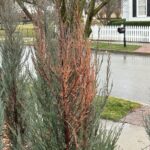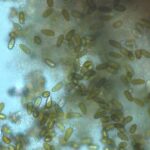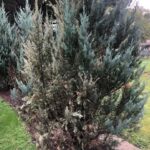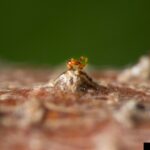Rocky Mountain juniper, Juniperus scopulorum, has gained some popularity in Midwest landscapes due to cold and drought tolerance, and to the availability of several upright columnar varieties with attractive blue color, including ‘Skyrocket’ and ‘Wichita Blue’. Like many other junipers, J. scopulorum may suffer dieback of small branches and twigs caused by the fungal pathogens Phomopsis and Kabatina. For a full discussion of those problems see the PLR article from 2017: https://www.purduelandscapereport.org/article/tip-blights-of-juniper/
The more serious threat to this plant comes from fungal canker and dieback pathogens, including Cytospora, Diplodia and Botryosphaeria. All three are common on many woody plants, but Rocky Mountain juniper appears to be especially susceptible. Large branches often die when infected by these pathogens, and as a result the shrubs become so disfigured they are eventually removed.
Like Colorado blue spruce, Rocky Mountain juniper is better adapted to dry climates in the western states. In humid regions with more frequent rain these dry climate-adapted plants face increased incidence of fungal infections. However, even in the Great Plains region junipers are reported to be frequently damaged by Botryosphaeria and another fungal canker pathogen: Seiridium. (https://www.fs.usda.gov/nac/assets/documents/research/publications/rmrs_gtr335.pdf).
Diplodia and Botryosphaeria are closely related fungi, produce similar symptoms and are managed in the same way. Both fungi are common in the environment and are spread by wind and water.
- Fig. 1. Diplodia canker and dieback on Juniper.
- Fig 2. Diplodia spores
- Fig. 3. Dieback of Juniper caused by Cytospora canker.
- Fig 4. Spores of Cytospora sp. being released from fruiting body. Photo: M. Dowling, Clemson University, Bugwood.org
Cytospora is less commonly found on Rocky Mountain juniper but can cause loss of major branches. It is often associated with various stress factors, including drought stress and wounding.
There is no ‘cure’ to transform this disease-prone shrub into a fully healthy plant but there are some things you can do to slow down the problem and make them look better.
- Prune out dead wood a few inches below any dead tissue but avoid unnecessary wounding otherwise.
- Clean pruning tools between cuts, by wiping with a disinfectant wipe or spraying with an alcohol solution.
- Once established, juniper is tolerant of dry weather but tends to be more susceptible to dieback if under stress. Plants may require some irrigation during extended drought but take care to avoid using a sprinkler. Instead, water only on the ground to avoid wetting foliage.
- Juniper generally needs little or no fertilizer, and if plants are fertilized, use a lower amount than typically recommended to avoid rapid growth, which might increase susceptibility. Slow and steady growth is more resilient than rapid growth.
- Fungicides are not generally effective in preventing spread of these diseases in the landscape.
- Plant in well-drained locations in full sun.



